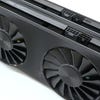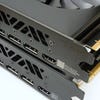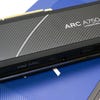Intel Arc A770 and A750 review: welcome player three
Aggressive price/performance, new features.
Intel's first enthusiast-grade graphics cards are here - and on the eve of AMD and Nvidia's transition to a new generation, Team Blue has actually done well. The $289 Arc A750 and $329/$349 Arc A770 offer surprisingly strong 1080p performance, a unique mix of features and aggressive pricing that makes them well worth considering for a mid-range PC - for most gamers, anyway.
Let's not get ahead of ourselves, though. There's loads to cover here and time is short, so let's take a quick overview of the hardware, cover the software features we're most interested in and then get into the meat of this review: gaming benchmarks.
We've got a brand new GPU test suite for late 2022, with a tranche of complete newcomers joining a remixed assortment of Digital Foundry favourites covering every major engine. It's a forward-looking test suite, with titles using modern APIs like DirectX 12 and Vulkan, which should give Intel a chance to demonstrate its strengths. Of course, we'll also be taking a look at performance in some classic 'banana skin' DX11 titles in our video review, where we expect Intel's first-generation Arc GPUs to have slightly more difficulty.
First though: the hardware. We tested two Intel Limited Edition models (think Nvidia's Founders Edition cards), the $289 Arc A750 and the $349 Arc A770 16GB. The design language here is more straightforward than Nvidia and AMD's reference designs, with a metal chassis, black plastic shrouds, gently rounded corners and two axial fans. The A770 16GB LE is differentiated with three zones of LED lighting (along the top of the card, around the fans and on the back), while the A750 LE goes without, but both cards occupy the same dimensions (27x10x4cm), require the same eight-pin plus six-pin power inputs and indeed are based around the same Alchemist G10 silicon. In terms of ports, we have one HDMI 2.1 port and three 40Gbps DisplayPort 2.0 ports on both of these dual-slot cards. Notably, both also include support for AV1 encoding, which isn't part of Nvidia's 30-series or AMD's 6000-series graphics cards and should help to stream or record in better quality at the same bitrate compared to H.264/H.265.
Models from other manufacturers, including GPU newcomers like Acer*, are reportedly coming soon with a range of price points and designs. Most notably, there's an 8GB variant of the A770 that retails at $329. Here's how the three models compare in terms of core specs - with the $129 Arc A380 that debuted in China earlier this year for context.
| Intel GPU | Arc A770 16GB | Arc A770 8GB | Arc A750 8GB | Arc A380 6GB | |
|---|---|---|---|---|---|
| Xe Cores | 32 | 32 | 28 | 8 | |
| Graphics Clock | 2100MHz | 2100MHz | 2050MHz | 2000MHz | |
| TBP | 225W | 225W | 225W | 75W | |
| Memory Size | 16GB GDDR6 | 8GB GDDR6 | 8GB GDDR6 | 6GB GDDR6 | |
| Memory Interface | 256-bit | 256-bit | 256-bit | 96-bit | |
| Memory Bandwidth | 560GB/s | 512GB/s | 512GB/s | 186GB/s | |
| Price | $349 | $329 | $289 | $139 |
Looking at the raw specs, the A750 and A770 ought to be strong alternatives to the RTX 3060 with advantages in most areas - including silicon produced on TSMC's 6nm node, the same as the recent PS5 refresh. The RTX 3060, based on Nvidia's Ampere architecture and produced on an older 8nm process, has a smaller die (276 mm² vs 406 mm²), a lower boost clock (1777MHz vs 2100MHz), less memory (12GB vs 16GB DDR6), less memory bandwidth (360GB/s vs 560GB/s) and draws less power (170W vs 225W). In a naïve comparison, the A770 looks like the better card - but Nvidia certainly has the advantage of experience, with many generations to hone both its architecture and its drivers against a newcomer to the discrete GPU space. So how do these cards compare in real-world testing?
To find out, we assembled a sturdy test rig. The A770 and A750 arrived too early to use Intel's 13th-gen parts - or AMD's Ryzen 7000 processors - so we've opted for something a little more mature, familiar and... available. That means a Core i9 12900K 16-core processor, locked to 5.2GHz on its performance cores and 3.9GHz on its efficiency cores, and kept cool with a beefy Noctua DH15 tower cooler. This top-tier CPU is backed with an Asus Z690 Maximus Hero motherboard, two 16GB sticks of G.Skill DDR5-6000 CL32 memory and a Corsair RM1000x power supply. For SSD storage, we have three drives at present: a 4TB Kingston KC3000, a 1TB PNY XLR8 CS3140 and a 1TB Crucial P5 Plus. Naturally, we're running Windows 11 with the latest graphics drivers installed for each of our three vendors. The idea here is to ensure that our graphics card is the bottleneck even at lower resolutions, and our game benchmarks have also been chosen with that in mind.
So - let's get into some game benchmarks, shall we? We'll begin with our new test suite, which includes 13 modern and remastered games across four pages, before doing some specific testing of Intel's XeSS upscaler against DLSS and wrapping up on the final page.
Intel Arc A770 and A750 analysis
- Introduction, test rig and hardware [this page]
- Gears 5, Shadow of the Tomb Raider, Doom Eternal
- Cyberpunk 2077, Metro Exodus Enhanced Edition
- Red Dead Redemption 2, Control, Forza Horizon 5
- Hitman 3, F1 22
- XeSS testing - Shadow of the Tomb Raider, Hitman 3
- Intel Arc A770 and A750 - the Digital Foundry verdict










